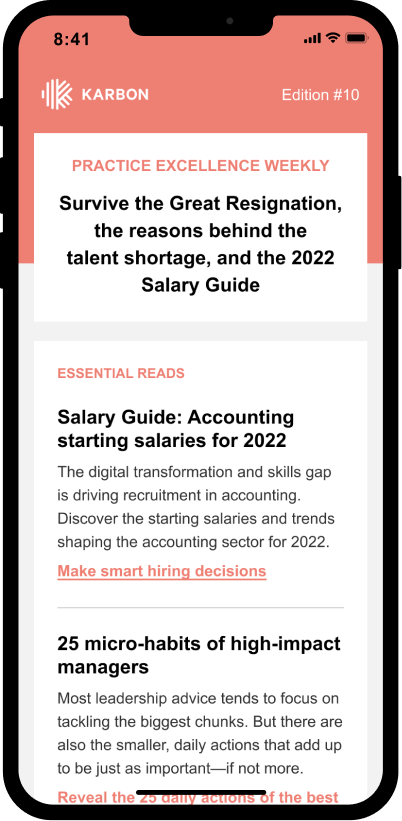Use a curated newsletter to garner trust and build your reputation
The art hanging in the Louvre is not painted by Louvre staff. Aside from them not actually being the likes of Leonardo da Vinci or Théodore Géricault, creating art isn't their job. Their job is to curate the masterpieces in the way that will have the most impact for patrons.

Your email newsletter can be thought of the same way—with you as the curator, and the online business and accounting community as your artists.
A regular newsletter can seem time-consuming and difficult to create. There can be a lot of pressure to produce interesting and relevant content. It might even seem like an unnecessary, self-imposed deadline that’s hard to meet consistently.
But a curated newsletter takes away the hardest part: producing the content. Instead, you source existing content online and use that to populate your newsletter. You become a knowledge leader without needing to put pen to paper.
Ryan Lazanis from Future Firm partnered with Karbon to deliver a private podcast series, The 7 Quick Win Marketing Tactics for Accounting Firms, highlighting quick (yet impactful) tactics you can implement today to grow your firm. In the last episode, Ryan discusses how curating a newsletter will build trust and position your firm as a group of industry experts.
This tactic isn’t quite as quick as the others in the series, but considering the relationships it helps forge with potential and existing clients, it’s well worth implementing. And once you’ve established your processes, you’ll be able to assemble and send it off quickly.
What are curated newsletters?
Curated newsletters are collections of articles, videos, news, information, and other types of content that your readers will find useful. They should cover a variety of topics that your audience is interested in, and utilize various mediums so there’s something for everyone—no matter how they like to ingest information.
There is no shortage of content online. The important thing is to ensure it’s of consistently good quality because this marketing tactic is built around trust.
If you share information that’s irrelevant or poorly sourced, it will have the opposite effect on your readership and you’ll lose credibility.
Why curated newsletters work as a marketing tactic
Curated newsletters are a form of email marketing, which several studies have shown to be one of the most effective marketing tactics. It boasts the highest ROI of any internet marketing tactic and is 40x more effective than social media in customer acquisition.
Email marketing’s benefits are well-known and leveraging them with a newsletter can be the difference between you and your competitors. You might be sending a company newsletter already, but a curated newsletter has the edge in a few ways:
All too often, businesses just talk about themselves. They send information about what is going on in their world, often ignoring what is going on for their clients. But a curated newsletter is made for the client. They’ll want to read it because it’s genuinely useful and actionable.
You don’t need to spend all your time writing. Once you have a system in place to flag and collect interesting content, you’ll be gathering what you need for your newsletter as you go about your normal business day—articles you see on your LinkedIn newsfeed, for example. Writing all the content from scratch per newsletter could easily take days, but a curated newsletter can take as little as 30 minutes (depending on complexity).
How to get started with a curated email newsletter
It just takes a few steps to put together your curated email newsletter:
1. Start bookmarking interesting content you see. Tax updates, YouTube videos on how to manage a business, LinkedIn articles that resonate with you, industry news, etc.—the list goes on and on. You can bookmark directly in your browser or you can use a free app like Instapaper to help gather and organize all the content.
2. Narrow it down to the top five. Five is enough to be informative—more than that and you risk your audience switching off, faced with a deluge of information. Also, keeping it relatively small means the quality of content can stay consistently high—it lets you select the crème de la crème for your newsletter.
3. Write an introduction. This doesn't have to be long. One or two sentences saying hello and introducing the newsletter. It might read something like this:
Hi there,
I know running a business can be hard work. Here are a few resources I thought you might find useful.
4. Link all your pieces of content. Write a short sentence introducing each piece when you link out to it, either a summary or an interesting part of the content—anything that will demonstrate why you’ve chosen to share it with your audience
5. Include a P.S. at the end of the newsletter. The P.S. should refer to one thing you want to advertise and have a clear CTA—it should be obvious the action you want the reader to take. For example, you might want the reader to sign up for a webinar you host on budgeting tips.
6. Send it. Once you’ve completed all of the above steps, you’re ready to send your curated newsletter. Using email marketing software like Mailchimp or ActiveCampaign can automate much of the process for you, making it even simpler to execute.
Tip: Decide on a schedule for your newsletter and stick to it. Any longer than a month between newsletters and this tactic will lose efficacy—a big part of it is becoming a regular, reliable source of information.
An example of a curated newsletter: Karbon’s Practice Excellence Weekly (PEW)
Karbon has a weekly curated newsletter called the Practice Excellence Weekly (or PEW for short), designed to curate the most valuable tips, tools, and tactics to help people run more profitable accounting firms and lead stronger teams.

What is PEW?
PEW is a weekly curation of content, each hand-picked specifically for accounting leaders by Karbon Magazine’s Editor-in-Chief, Jess Marcello.
All the content is pulled from reputable sources and contains actionable suggestions, tips, advice, and insight about running an accounting firm, developing as a leader, and managing a high-performing team.
To keep things consistent for readers, PEW is always broken into three sections:
Quick hits. You don’t need to click these to learn from them—they’re designed to give you at least one valuable takeaway, without having to click anywhere. A tweet, a stat, and a quote for quick accounting dopamine. It’s new, interesting information that’s easily digestible.
Essential reads. This section is for longer reads and more in-depth information. Three articles are selected each week for their value to accounting professionals. For example, they might explain why you should schedule all your emails, or hone in on best practices for remote collaboration.
Listen, watch, attend. The home of informative videos, webinars, and podcasts. It might include conversations with accounting leaders or webinars about process efficiency.
Why does PEW exist?
PEW is designed to cut through the noise. It’s the newsletter accounting leaders can rely on to bring them relevant, genuinely useful and valuable resources, in one place, each week.
How can you sign up to PEW?
Sign up for Practice Excellence Weekly here to receive an impactful newsletter every week.
Curated newsletters build your reputation
Over weeks, months, and years, recipients of your curated newsletter will become more familiar with your name and will begin to associate you with quality and reliable information. You’re nurturing an ongoing relationship with your readers. When they have accounting questions, or they’re looking to employ accounting services, your reliability will make you their go-to firm. Because the more trust you build with your readership, the more your accounting firm will grow.